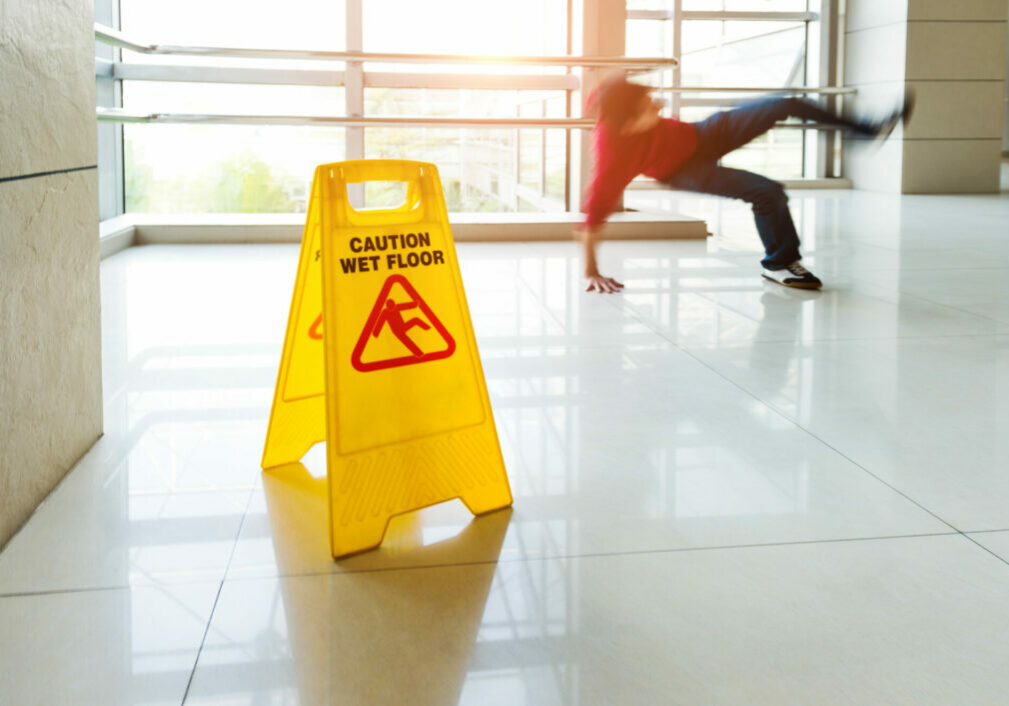By Dr. Derek Shendell, Dr. Koshy Koshy and Justin Panzarella
There are over 13 million school employees in the United States with nearly 230,000 here in New Jersey. They make up the many education professionals, all of whom may be exposed to occupational hazards at schools. From the 2009-10 through 2013-14 school years, a study found slips, trips and falls to be the leading cause of employee work-related injuries in K-12 schools as documented by worker compensation claims.
Slips, trips and falls
The latest U.S. Bureau of Labor and Statistics report shows that, from 2020 to 2021, the number of work-related injuries caused by slips, trips and falls increased by 40% in U.S. public elementary and secondary schools. There were 165,700 work-related injuries in 2021 and 218,900 injuries in 2019, prior to the COVID-19 pandemic.
These nonfatal injuries may lead to lost time and possibly multiple days away from work. They can also lead to a disability. Injuries can include, but are not limited to, dislocations, fractures, sprains, strains, contusions, concussions, tears to lower extremities, and even paralysis.
School parking lots
The federal Occupational Health and Safety Administration (OSHA) regulates walking-working surfaces under 1910.22 general requirements. In New Jersey, public sector workers also have Public Employees Occupational Safety and Health (PEOSH).
Under its general requirements, OSHA tells the employer that walking-working surfaces should be maintained free of hazards, such as sharp or protruding objects, loose boards, corrosion, leaks, spills, snow and ice. This section includes parking lots as a “walking-working” surface. [See 1910.22(a)(3)]. Therefore, it is required that these areas are inspected, maintained and repaired.
School parking lots can have hazards that include uneven sidewalk slabs, cracks in pavement, potholes, broken surfaces, loose and irregular surfaces and puddles. Weather conditions such as rain, fog, mist and snow can contribute to slips, trips and falls. Poor lighting at night can make these surfaces harder to see, increasing the chances of a work-related injury. School parking lots should provide ample lighting and light fixtures should be replaced as needed.
Best practices
Employers are required to address hazards in the workplace and local associations can play a role in making sure employers do so. Safety measures can minimize work-related slips, trips and fall injuries in classrooms, hallways, maintenance rooms, parking lots, kitchens and other parts of the campus.
As schools evolve, new hazards present themselves. Many schools, for example, have transitioned from writing on whiteboards and chalkboards to electronic devices. As a result, cords from these devices may create a tripping hazard. Proper cord management such as providing additional outlets, hooks, cable path tape, desk outlets and cord covers are all practices that may reduce work-related injuries. Walking pathways should be kept clear of items such as backpacks, books, hoses, tools and other objects.
Slippery floors can be a result of recently waxed or polished floors, spills, loose floormats and transitioning from carpeted to vinyl floors. Spills should be cleaned immediately. Floors that are wet, polished or waxed should be demarcated with a proper caution sign. Custodians should have ample warning signs to post in case of spills. Loose floormats should also be checked periodically to ensure they are in the correct location.
Falls can occur from the same level or an elevated level. Causes of falls from the same level may include loose carpeting, clutter, cords, missing floor tiles and poor lighting. A fall from an elevated level may result from ladders, stairs and unsecure floor openings. All employees should be properly trained in ladder safety and fall protection.
Employees should be trained not to use a chair or desk as a ladder. Ladder use policy needs to include best practice for placement and inspection before each use to ensure safety. Damaged equipment should be labeled not to use. Stairs should have non-slip stair treads and guardrails. Floor openings above level should also be provided with guardrails.
Work-related falls in school kitchens may result from spilled water, oil, food, grease or any other fluid. The kitchen area should be supplied with floor mats to prevent slips, trips and falls. Food service and/or custodial staff should be trained to clean the floors as often as necessary and floor drains should be cleaned periodically to prevent cloggage. First-aid kits should be supplied and accessible in all designated workstations.
What local associations can do
All employees should report any identified hazard to their employers immediately to prevent future work-related injuries. If the reported unsafe working condition is ignored, reach out to your union representative.
In some cases, work-related injuries may be under-reported as employees may fear retaliation. If this is the case, report the hazards to your union representative or health and safety committee member.
The local association should create, expand, and/or enhance their health and safety committee to oversee safety and health issues including avoidable slips, trips and falls.
Dr. Derek Shendell is a professor and Dr. Koshy Koshy is an associate professor at the Rutgers School of Public Health where Justin Panzarella is a registered environmental health specialist and working toward his master’s degree in public health, majoring in occupational safety. They worked in coordination with the New Jersey Work Environment Council to produce this article.
References and resources
U.S. Bureau of Labor Statistics
The Economics Daily
“A look at work injuries and illnesses in elementary and secondary schools.”
California Department of Industrial Relations
School Action for Safety and Health (SASH) Program
Ohio Bureau of Workers’ Compensation
Safety Talk: Parking Lot Safety
Occupational Safety and Health Administration
